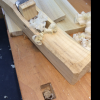Well, it has been pretty slow around here, but one thing I have been looking for is a small anvil. Not for Smithing work per se, just for tapping out dings, adding planishing marks, etc.
Originally from the Prairies, anvils of all sizes were a dime a dozen. West Coast, rare as hens teeth.
At a garage sale on Saturday, I looked under a table and there it sat. Not in great shape at all, but nothing I can't deal with. I guessed about 40-50 pounds; it is 40 on the nose. Perfect for the bench top.
Looked up FISHER anvil on the 'net, turns out this little puppy is from 1895, and is marked as a 40 pounder!! Lucky me. The ask; a couple bucks, she was thrilled when I gave her five, wouldn't take any more. They were her Dad's tools; she was just happy that it was going to be put to use.
I will get the top machined; May or may not bead blast it. It is in pretty poor shape in that regard.





 Reply With Quote
Reply With Quote




